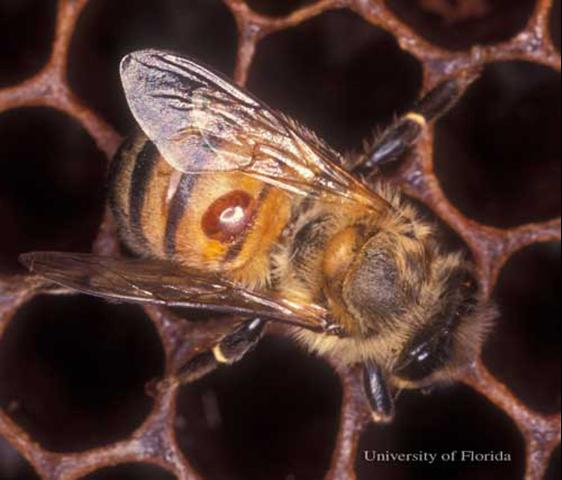15.00

The varroa mite, Varroa destructor is the world’s most devastating pest of Western honey bees, Apis mellifera. Although the varroa complex includes multiple species, Varroa destructor is the species responsible or the vast majority of the damage attributed to mites from this genus.
Varroa mites are external parasites that pierce the body covering and suck the blood of adult bees and brood. Mite reproduction occurs only in brood cells, but adult mites are mobile and cling to adult bees in order to move within and between bee colonies. The life cycle begins when a mated female drops off a worker bee and enters a brood cell; female mites prefer drone (male) brood. The mite buries herself in the brood food at the bottom of the cell and stays there until the larva’s feeding activity uncovers her several hours after the cell is capped. The mite then feeds on the blood of the larva or pupa and lays an egg about every 30 hours. Siblings mate in the cell, and mated females leave with the emerging bee to start the cycle over again.
Mite Detection
The mite load or threshold number at which point treating honey bee colonies becomes critical is about 3,000 mites per colony. Below are recommended monitoring techniques that can be used to track the mite load in your honey bee colonies.
Visual – You can sometimes detect mites simply by examining adult bees or brood. Mites are oval-shaped, copper colored, and about the size of a pine head. On adult bees they look like a large freckle. This method, however, will not provide you an estimate of the mite load in your colony.
Other methods of detecting or monitoring the mite load in your colony are:
Sugar Roll – take a quart canning jar and replace the lid with a screen of 8 mesh hardware cloth. Add on tablespoon of powdered confectioners’ sugar to the jar then brush about 300 bees (1 ½ inches deep) directly from a brood comb into the jar. Roll the bees gently until they are full coated, then dump the sugar through the screen into a white pan containing water. The screen traps the bees while allowing the sugar-coated mites to fall through the screen into the water. The sugar dissolves away and the mites are visible against the white pan.
Ether Roll – Similar to the sugar roll, Varroa mite population can be detected by collecting 1.5 inches of adult bees in a glass canning jar. Ether (engine starter fluid) is prayed into the jar and the lid of the jar securely fastened. The mites detach from the bees and can be seen stuck to the inside walls of the jar.
The treatment threshold (the number of mites detected where mite control becomes economically and biologically beneficial) for mites per 100 bees using the sugar roll or ether roll = 3 mites/100 bees (or 9 mites from a jar of ~ 300 bees).
Detector boards or sticky sheets – Leave Detector boards or sticky sheets in the hive for a few days and inspect for mites.
The treatment threshold is 60 mites on the screen per day. For example, screen left in colonies for 3 days and having 180 mites (an average mite fall of 60 mites per day), thus reaching the economic threshold to initiate mite control.
Treatment options:
- Apistan (Tau-fluvalinate) use 1-2 strips per brood chamber leave in hive for 6-8 weeks.
- Checkmite – Coumaphos (organophosphate), use 1-2 strips in hive for 42-45 days
- Apivar – Amitraz (formamidine), use 1-2 strips per brood cover, leave strips in hive for 42 days.
- Apilife Var– Thymol, best in early spring or late fall (between 68° and 86°), place tablet (broken into four pieces) on broad nest. Replace every 7-10 days for a total of 3 applications.
The use of essential oils to control mites is another interesting option that is gaining popularity. This option, however, needs more investigation before specific recommendations can be made. There is generally a lack of standardized application procedures and dosing for essential oils, and the effects (if any) of the oils on the honeybees are not completely known at this time.
15.00
Normal
0
false
false
false
EN-US
X-NONE
X-NONE
/* Style Definitions */
table.MsoNormalTable
{mso-style-name:”Table Normal”;
mso-tstyle-rowband-size:0;
mso-tstyle-colband-size:0;
mso-style-noshow:yes;
mso-style-priority:99;
mso-style-parent:””;
mso-padding-alt:0in 5.4pt 0in 5.4pt;
mso-para-margin:0in;
mso-para-margin-bottom:.0001pt;
mso-pagination:widow-orphan;
font-size:10.0pt;
font-family:”Times New Roman”,”serif”;}
Other Considerations:
15.00
Normal
0
false
false
false
EN-US
X-NONE
X-NONE
/* Style Definitions */
table.MsoNormalTable
{mso-style-name:”Table Normal”;
mso-tstyle-rowband-size:0;
mso-tstyle-colband-size:0;
mso-style-noshow:yes;
mso-style-priority:99;
mso-style-parent:””;
mso-padding-alt:0in 5.4pt 0in 5.4pt;
mso-para-margin:0in;
mso-para-margin-bottom:.0001pt;
mso-pagination:widow-orphan;
font-size:10.0pt;
font-family:”Times New Roman”,”serif”;}
Remember, when using any pesticides, THE LABEL IS THE LAW. Read it, and follow it! Always follow directions and wear gloves and other protective gear that is listed on each pesticide label. Avoid chemical control treatments (in hive) during periods of honey flow.
Sources of Information:
Dr. Dan Schmehl, Dr. James D. Ellis, and C.M.Zettel Nalen, University of Florida Entomology and Nematology Department, IFAS. Honey Bee Research and Extension Lab, UF/IFAS
15.00
Normal
0
false
false
false
EN-US
X-NONE
X-NONE
/* Style Definitions */
table.MsoNormalTable
{mso-style-name:”Table Normal”;
mso-tstyle-rowband-size:0;
mso-tstyle-colband-size:0;
mso-style-noshow:yes;
mso-style-priority:99;
mso-style-parent:””;
mso-padding-alt:0in 5.4pt 0in 5.4pt;
mso-para-margin:0in;
mso-para-margin-bottom:.0001pt;
mso-pagination:widow-orphan;
font-size:10.0pt;
font-family:”Times New Roman”,”serif”;}
Varroa Mite, Varroa destructor Anderson and Trueman (Arachnida: Acari:Varroidae)
Normal
0
false
false
false
EN-US
X-NONE
X-NONE
/* Style Definitions */
table.MsoNormalTable
{mso-style-name:”Table Normal”;
mso-tstyle-rowband-size:0;
mso-tstyle-colband-size:0;
mso-style-noshow:yes;
mso-style-priority:99;
mso-style-parent:””;
mso-padding-alt:0in 5.4pt 0in 5.4pt;
mso-para-margin:0in;
mso-para-margin-bottom:.0001pt;
mso-pagination:widow-orphan;
font-size:10.0pt;
font-family:”Times New Roman”,”serif”;}
15.00
 0
0
